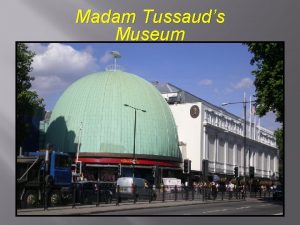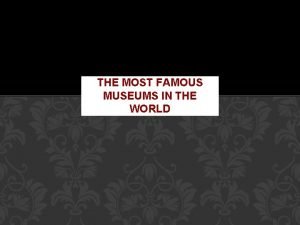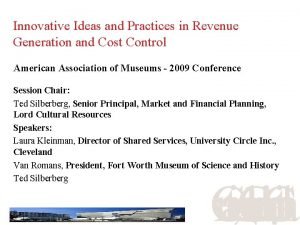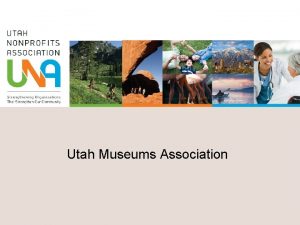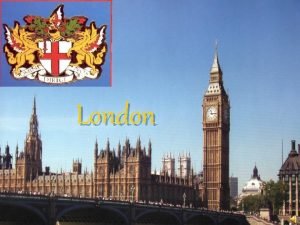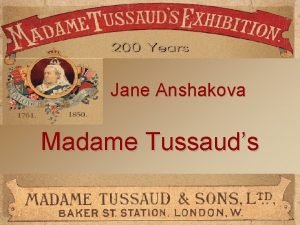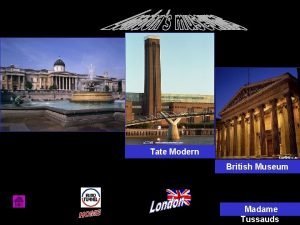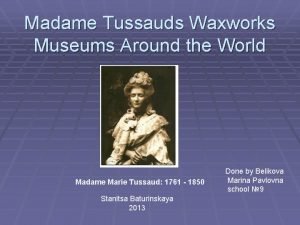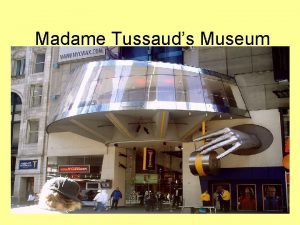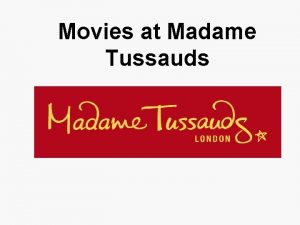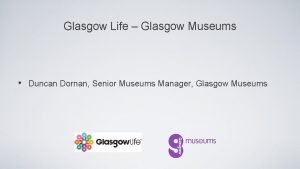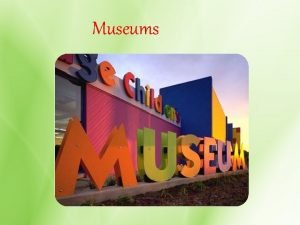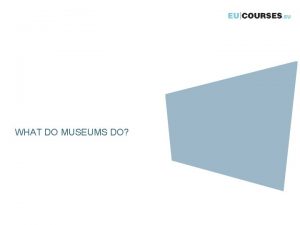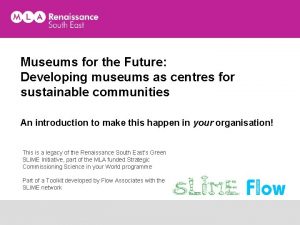MUSEUMS Madam Tussauds Madam Tussauds is the most















- Slides: 15

MUSEUMS

Madam Tussauds Madam Tussaud's is the most popular and talked about wax museum in the world. There are wax models of the famous and infamous, both living and dead, from every walk of life. Elvis Presley, the Beatles, the Rolling Stones, Marilyn Monro, Michael Jackson, Alfred Hitchcock, Charlie Chaplin, the British Royal family, Bill Clinton, Jack the Ripper. . . There is no other place where you can see all the celebrities at once, even if they are only wax figures. So if you want to rub shoulders with kings and queens or the latest pop stars, or probably with notorious criminals, this is the place to go. The museum is situated in Marylebone Road, not far from the street which is famous as the home of the first great detective in fiction, Conan Doyle's Sherlock Holmes.

There's usually a long queue in front of the museum. No wonder! Many tourists would consider their trip to London worthless if they didn't visit the famous Madam Tussaud's. There are several halls at Madam Tussaud's. Highlights include the Grand Hall, the Chamber of Horrors and "The Spirit of London" exhibition. The wax figures are standing and sitting, and sometimes even moving and talking. They are extremely realistic and when they look at you, their eyes sparkling, you often feel uncomfortable in their company. Computer controlled figures (they are called audioanimatronics) are especially popular with the visitors. New models are being produced all the time while the old ones are quietly removed from display. Over the years hundreds of celebrities have made their way to Madame Tussaud's studio. Most people agree to be portrayed, but some refuse. Mother Teresa was one of the few who declined, saying her work was important, not her person.

Natural History Museum Both a research institution and a fabulous museum, the NHM opened in Alfred Waterhouse’s purpose-built Romanesque palazzo on the Cromwell Road in 1881. Now joined by the splendid Darwin Centre extension, the original building still looks quite magnificent. The pale blue and terracotta façade just about prepares you for the natural wonders within. Taking up the full length of the vast entrance hall is the cast of a Diplodocus skeleton. A left turn leads into the west wing or Blue Zone, where long queues form to see animatronic dinosaurs- especially endlessly popular T rex. A display on biology features an illuminated, mansized model of a foetus in the womb along with graphic diagrams of how it might have got there.

A right turn from the central hall leads past the ‘Creepy Crawlies’ exhibition to the Green Zone. Stars include a cross-section through a Giant Sequoia tree and an amazing array of stuffed birds, including the chance to compare the egg of a hummingbird, smaller than a little finger nail, with that of an elephant bird (now extinct), almost football-sized. Beyond is the Red Zone. ‘Earth’s Treasury’ is a mine of information on a variety of precious metals, gems and crystals; ‘From the Beginning’ is a brave attempt to give the expanse of geological time a human perspective. Outside, the delightful Wildlife Garden (Apr-Oct only) showcases a range of British lowland habitats, including a ‘Bee Tree’, a hollow tree trunk that opens to reveal a busy hive. Many of the museum’s 22 million insect and plant specimens are housed in the new Darwin Centre, where they take up nearly 17 miles of shelving. With its eight-storey Cocoon, this is also home to the museum’s research scientists, who can be watched at work. But a great deal of this amazing institution is hidden to public view, given over to labs and specialised storage. The latest edition to the Museum is a human evolution gallery exploring where we come from and what makes us human. Casts of the reconstructed skull, hand foot of Homo naledi feature in the display, alongside the first adult Neanderthal cranium ever discovered.

Welcome to 221 B Baker Street! The Sherlock Holmes Museum is open every day (except Christmas Day)

According to the stories written by Sir Arthur Conan Doyle Sherlock Holmes and Doctor Watson lived at 221 b Baker Street was built in 1815 and has been preserved as a fine example of a building and interior from that period. The house is decorated exactly as described in the books by Arthur Conan Doyle and so any fan of Sherlock Holmes will be familiar with the setting. Although you are free to wander around the Sherlock Holmes Museum by yourself, on some days you may come across Dr. Watson or Mrs. Hudson who will be able to answer any questions you may have.

1 st floor Study - Sherlock is famous for sitting in study with Dr Watson, smoking his pipe or playing his violin as he mulled over various aspects of his case. So this room is probably the famous and well known room in the house. Visitors are allowed to have their picture taken sitting in his famous chair by the fireside and to wander through into his bedroom, which looks like he has just left it. Many of his personal items are scattered around the room just as he would have left them, such as his pipe, notebook and slippers. 2 nd Floor Dr Watsons room - This is situated at the back of the house and overlooks a small courtyard where you can imagine him sitting and wondering what scrapes the pair were going to get into next. Mrs Hudson's room - This room is situated at the front of the house. Mrs Hudson was the landlady of the house and also seemed to be Mr Holmes personal housekeeper too as she prepared all the meals and did all of the household chores.

3 rd Floor Scenes from the stories - On the third floor a rather unusual exhibition has been arranged which depicts various scenes from some of the Sherlock Holmes Books. Wax figures of all the main characters can be seen as well as some of the scenes and villains from the stories are displayed. Shop - A shop is located on the ground floor where you can buy all sorts of Holmes related items.

The Tower of London was built by William the Conqueror towards the end of 1066. Over the centuries the Tower of London has been used as a royal residence, an armoury, a treasury, a zoo, the Royal Mint, a records office and to house the Crown Jewels. It is run by the Constable of the Tower, who is chosen from the leading nobility and courtiers. On four occasions the Constable has also been Archbishop of Canterbury. Tower prison The Tower wasn’t built as a prison but it was convenient to keep state prisoners there, as it was near the courts in Westminster and was a Royal Stronghold. Bishop Flambard, a former Constable of the Tower, was the first prisoner, and the first escapee. Many prisoners have carved their names into the walls of the Tower.

Tower mint The Royal Mint was set up at the Tower of London in 1278. At the time, many of the coins in circulation were minted locally around the country. Henry VIII changed the system so that only the Royal Mint could produce coins. This earned him the nickname Old Copper Nose because the gold and silver soon rubbed off his new coins, exposing the copper beneath, particularly on the nose of Henry’s portrait. He used the gold and silver he saved to cut the debts accrued by fighting foreign wars and building beautiful palaces. Tower zoo For over 600 years there was a royal menagerie in the Tower of London. It was founded by King John in the early 1200 s and was filled with exotic animals given as royal gifts for the entertainment and curiosity of the court. The first animals to arrive were lions, an elephant and a polar bear which would hunt for fish in the Thames on a lead. Later came tigers, kangaroos and ostriches. Remains found in the tower have confirmed that the medieval big cats were male Barbary lions, a now extinct subspecies from North Africa. The menagerie was closed by the Duke of Wellington in 1835 and the animals became the basis for London Zoo in Regent’s Park.

Tower ravens “If the ravens leave the Tower, the kingdom will fall…” is the old superstition. But the earliest reference to a raven in the Tower only dates back to 1885 (a picture in Pictorial World newspaper). Today seven ravens (including Baldrick and Marley) are kept at the Tower, and they each have a wing clipped to ensure they can’t fly far (although one – Grog – made it as far as a pub in the East End in 1981). All but one of the Tower ravens died from stress during the Blitz. Tower jewels The Tower has been home to precious jewels since William the Conqueror began storing treasure there. Today there are over 23, 578 jewels, and the most impressive single piece is the Imperial State Crown, which contains 2000 diamonds, 200 pearls, 17 sapphires, 11 emeralds and five rubies.

The Clink Prison Museum is built upon the original site of The Clink Prison, which dating back to 1144 was one of England’s oldest and most notorious prisons.

Spanning for over 600 years, it witnessed a remarkable amount of social and political change in England, and thus housed a multitude of sinners throughout its existence, including debtors, heretics, drunkards, harlots, and later religious adversaries. Positioned in the heart of modern day Southwark, the prison was situated in an area that has long been associated with more raucous, vivacious and unruly behaviour; it was the louder, ruder and wickeder neighbour to The City, and a place where Londoners sought entertainment. Visitors will learn all about this scandalous truth of Old Bankside through a hands-on educational experience, with the opportunity to view archaeological artefacts, handle torture devices, and to view and hear all about the tales of torment and many misfortunes of the inmates of the infamous Clink Prison.

THANK YOU FOR ATTENTION!!!
 Francis tussaud
Francis tussaud Famous museums of the world
Famous museums of the world Archives and museums du study material
Archives and museums du study material Peace museums
Peace museums Innovative ideas for revenue generation
Innovative ideas for revenue generation Utah museums association
Utah museums association Nyu museums
Nyu museums Royce hall
Royce hall Covent garden to madame tussauds
Covent garden to madame tussauds Madame tussauds biography
Madame tussauds biography British museum madame tussauds
British museum madame tussauds Madame tussauds around the world
Madame tussauds around the world Complaint letter writing
Complaint letter writing He clattered and clanged as he washed the dishes
He clattered and clanged as he washed the dishes Dialogue in a clothes shop
Dialogue in a clothes shop Seems madam nay it is
Seems madam nay it is
